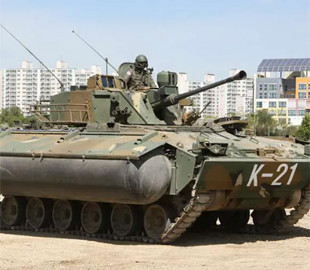
As reported by the South Korean business magazine "Business Korea" Latvia is looking to boost its military capabilities by adding South Korea's advanced K21 infantry fighting vehicle.
Details
The Ministry of Defense of Latvia is in the midst of a large-scale process of evaluating and selecting the appropriate BMP to increase the combat capabilities of its armed forces. The project envisages the purchase of 100 state-of-the-art BMPs to strengthen the country's defense capabilities. Among the applicants – Hanwha Aerospace K21, ASCOD from General Dynamics European Land Systems and Tulpar from Turkish defense manufacturer Otokar.
During a rigorous three-week testing phase conducted in October 2023, the K21 underwent a comprehensive evaluation focusing on its mobility and firepower capabilities. According to the tests conducted by the Latvian Armed Forces, the K21 became the leader, significantly surpassing its competitors in both evaluated aspects. The unsurpassed firepower of the tank combined with its competitive price, which is 30-40% cheaper than its counterparts, made it the best choice for Latvia.
Designed to modernize the armored vehicles of the Republic of Korea (ROK) Army, the K21 infantry fighting vehicle is a significant improvement over its predecessor, the K200 series. The K21 journey began with the delivery of three NIFV prototypes to the South Korean Army in 2005 by Doosan DST, after decades of development and improvement. Its production began in 2009 after a contract was signed in October 2008 with the Defense Acquisition Program Administration (DAPA) of the South Korean Ministry of Defense. This initial contract, worth $386.7 million, was for the supply of the first batch of K21 armored vehicles.
Armed with a robust twin turret, the K21 has a 40mm gun along with two anti-tank guided missile launchers. The impressive rate of fire of the gun reaches 300 shots per minute, and the speed of projectiles reaches 1005 meters per second. Its armor-piercing projectiles with stabilized keel (APFSDS) are capable of penetrating up to 220 mm of armor thanks to the self-sharpening feature. In addition to the main armament, the machine is equipped with anti-tank guided missiles of the third generation, the characteristics of which can be compared with the Israeli Spike missile, capable of penetrating armor up to 1000 mm thick. A twin machine gun of 7.62 mm caliber acts as an additional weapon.
The operational crew of the K21 consists of three people, with the additional ability to carry up to nine fully equipped soldiers. Entry and exit for troops is facilitated by a power-operated ramp that includes integral doors, while hatches in the roof provide additional access points for firing and emergency egress. The K21 armor system includes layers of fiberglass, ceramic, and aluminum alloy, providing frontal protection against 30mm armor-piercing rounds and full protection against 14.5mm armor-piercing rounds.
Equipped with a South Korean Doosan D2848LXE turbocharged diesel engine with a capacity of 680 horsepower. BMP K21 develops a maximum speed of 70 km/h and boasts a maximum range of 450 km. Its hydropneumatic suspension and folding undercarriage emphasize its mobility. Designed for amphibious operations, the K21 can transition to water activities with minimal training using automatic built-in "bags" for buoyancy. Once in the water, the vehicle is propelled by tracks, reaching speeds of up to 6 km/h, allowing it to effectively cross lakes and rivers.
The recent success of South Korea's defense industry highlights a significant trend in global military procurement, emphasizing the growing influence of South Korea in the defense sector. In addition to Latvia, which is considering the acquisition of Hanwha Aerospace's K21, other well-known contracts such as Poland's acquisition of K2 Black Panther tanks and Australia's decision to purchase the AS21 Redback BMP. South Korea's defense products are increasingly recognized for their advanced technology, reliability and cost-effectiveness. These achievements not only mark a significant shift in the diversification of military suppliers by countries around the world, but also confirm South Korea's position as a leading exporter of state-of-the-art military equipment for the world's ground forces.

